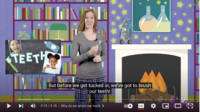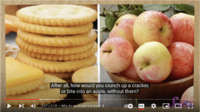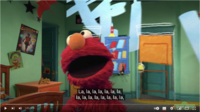Generative Processing
Overview[edit | edit source]
The Cognitive Theory of Multimedia Learning posits that, in order for meaningful learning to occur, the learner must be able to select material to process, organize that material into a verbal or pictorial representation, and integrate those representations with prior knowledge[1]. During the learning process, there are three demands on cognitive capacity: extraneous processing, during which a learner is distracted by irrelevant material, essential processing, occurring when the learner is able to select material and hold it in working memory, and generative processing, which occurs when the learner is motivated and able to make sense of the selected material by reorganizing and integrating it with existing knowledge[1]. Generative processing occurs when a learner is able to make connections between what is being learned with what they already know and is supported by activity that prompts learners to take a more active role in engaging with the material.
One of three assumptions within the Cognitive Theory of Multimedia Learning that describe the different ways learners receive and interact with material, the active processing assumption holds that learners are served well by active learning opportunities, rather than passively receiving information as, for example, a computer holds a saved text or image file[1]. By offering such generative learning activities, students may be more motivated to engage with the material in order to build mental models, or schemas[1]. Several principles have been identified to support generative processing during learning. When implemented well, they can help the learner manage cognitive load. Cognitive Load Theory suggests three categories of cognitive load: intrinsic, extraneous, and germane. Moreno and Mayer explain that these categories should be taken into consideration when designing multimedia learning and that learning environments should aim to reduce cognitive load expended on extraneous information, help students understand what material should be selected, and support the integration of that selected material within existing knowledge[2]. A goal for instructional designs should be to decrease extraneous load to increase working memory resources, which, in turn, will increase germane load and support learning[3] through generative processing.
The Cognitive Theory of Multimedia Learning suggests several principles that foster generative processing, including, but not limited to, Personalization, Reflection, Self-Management, Emotional Design, and Learner Control. Learning designers should consider such principles when designing content as ways to actively engage learners with the material.
Evidence[edit | edit source]
Following the principles of the Cognitive Theory of Multimedia Learning, Lo and Tsai developed a virtual reality learning environment that includes interactive elements throughout fifteen video clips as part of a study on how VR content can promote effective learning. Within the instructional goal of generative processing, the VR program utilized the personalization and voice principles, which suggest that using friendly, human narration is more effective than formal, robotic narration. It also utilized the learner control principle, enabling the learner to work at their own pace and prompt interactivity by performing certain actions. Participants’ levels of flow experience, learning motivation, learning interaction, self-efficacy, and presence were examined via pre- and post-questionnaires, and responses to the questionnaires were compared to demonstrate this effective learning tool[4]. This suggests that the multimedia learning principles that were applied to the design of the virtual reality environment support meaningful learning.
In Zhang et al.’s study of whether interactivity in videos promotes more effective learning, students in an e-learning environment containing interactive videos were found to have higher levels performance and and learner satisfaction than students in e-learning environments with non-interactive video and with no video, as well as students in a traditional classroom space[5]. The interactive videos were designed to allow for students to control how and when they watched a given segment, which allowed them to easily re-watch a particular section if they needed to review material for deeper understanding, which fosters students’ ability to select, organize, and integrate material.
Design Implications[edit | edit source]
In order to foster generative processing and facilitate germane cognitive load, learning designers must eliminate extraneous processing and manage essential processing[2]. They suggest that including elements such as personalized narration, feedback, and reflection offer students the opportunity to take an active role in learning the material, which is likely to support meaningful learning[2]. However, an important consideration for learning designers who are creating material is the learner’s prior knowledge. Additionally, the three demands on cognitive capacity are different for every learner, which is something learning designers should consider when creating material[1].
The following examples support learners’ ability to select important material, organize it, and integrate it within their existing knowledge by following various principles that foster generative learning:
Why Do We Brush Our Teeth? | Health for Kids | SciShow Kids[edit | edit source]
https://www.youtube.com/watch?v=aOebfGGcjVw | Retrieved 12/10/2022
Utilizes principles including personalization, voice, guided discovery
- In this video, the main character/host is a real person against an illustrated background, who interacts with an animated robot-mouse named Squeaks and the viewers. The background offers a visually appealing experience in which young viewers can relate to some of their favorite picture books, and the host speaks in an animated and friendly manner to the viewers.
- The video shows a mix of clips that include the host speaking to Squeaks and to the viewers. Photos and animations with descriptive and/or explanatory narration are also displayed.
- Although fast-paced, the video helps the young viewer understand the importance of brushing one’s teeth and the risks associated with not brushing, such as bacteria growth and cavities. The content creators also inject humor to engage the viewer; for example, when discussing the need to brush one’s teeth in the morning, the video portrays an animation of dancing bacteria in the mouth with the inclusion of lights associated with a dance club (3:38).
- In contrast with many women presenting in various forms of media, the main character is a woman who is not wearing a noticeable amount of makeup. Women on screen (at least in the United States) are often shown wearing makeup to highlight their features (e.g., dark eyeliner, colorful eye shadow, eyelash extensions, bright lip color). This could be an example of personalization, as many adult women who interact with young learners are likely not wearing full makeup in the way a typical tv host would. Young viewers may find the host to be more relatable and accessible because of this and also because she is casually dressed in pajamas.
- While presenting, the host frequently asks viewers questions to help them think about why brushing their teeth is important (e.g., 0:27), demonstrating the guided discovery principle.
Let's Talk Cubes Game[edit | edit source]
https://www.learningresources.com/item-lets-talk-cubes | Retrieved 12/01/2022
Utilizes principles including personalization, guided discovery, self-explanation, and learner control
- This game is intended to promote social-emotional learning. The cubes are color-coded by category; orange cubes have ice-breaker questions, blue cubes have social skills prompts, and green cubes contain prompts relating to emotions and feelings. The questions and prompts are crafted in a conversational way that can be understood by young children.
- Players can select the category of their choosing and can roll the cube to select a question or prompt to which they will respond.
- The questions/prompts on the orange cubes are light questions that are useful as a tool for players to get to know one another.
- The questions/prompts on the green cubes encourage the player to reflect inwardly and articulate what they value and how they perceive themselves.
- The questions/prompts on the blue cubes require the players to reflect outwardly as they consider complicated scenarios that they might not otherwise have thought about (e.g., “Someone is being made fun of. What should you do?”). * If and when the players encounter these scenarios, or similar, in real life, the activity with these cubes is intended to help players respond appropriately and productively.
- Although not specified on the product website, it might be helpful for players to start with the orange (ice breaker) cubes and work their way through the green (emotional/feelings skills) cubes before concluding with the more challenging blue (social skills) cubes.
- This game is casual enough for a player to re-roll a cube if they do not wish to answer a given question. Doing so may weaken the goal of the game, but this is in line with a challenge to the learner control principle. Alternatively, giving students this type of choice may help them develop deeper thinking skills in an area in which they are more comfortable, allowing players to build up to the tougher questions.
Sesame Street: Drawing | Elmo's World[edit | edit source]
https://www.youtube.com/watch?v=MtxYRysBbIE | Retrieved 12/14/2022
Utilizes principles such as personalization, embodiment, guided discovery
- The Elmo’s World series starts with an opening song that Elmo sings while in a bedroom young viewers might be able to imagine themselves in.
- A particular brand of puppet, Elmo speaks in a welcoming, conversational way, and moves in a human-like manner throughout the video. Also demonstrating the embodiment principle, an illustrated cow with a human-like smile (0:34), a somewhat anthropomorphized cell phone friend, “Smarty” (0:52), a dog playing a ukulele (3:39), and a fish with eyelashes and a smile (4:33) are also shown in the video.
- In this video, Elmo wants to learn about drawing. The viewers are shown different types of drawing tools, and Smarty explains the drawings can be based on things that can be realistic or abstract and imagined (1:25).
Elmo and Smarty prompt the viewer with questions like “What do we do to learn something new?” (“We look it up!”) (1:05) * Following the guided discovery principle, this technique may help a young learner understand that it’s okay if they don’t know something and that they can find the tools to help them figure out what they need to know.
- In another example of guided discovery, the viewers are asked to guess what Elmo is drawing (2:18). As Elmo draws a rectangle shape and adds in additional triangles and lines, a group of children off-screen describe what Elmo is drawing while questioning what the final image will be. Ultimately, it becomes clear that the drawing is of a sailboat. (2:51)
The following example does not sufficiently foster generative processing:
Using Light Painting to Teach Bioluminescence[edit | edit source]
https://ocean.si.edu/ocean-life/using-light-painting-teach-bioluminescence | Retrieved 12/01/2022
- While a fun experiment, this exercise is a lost opportunity to learn more about bioluminescence, as well as photography.
- The video and text instructions include opening the shutter and closing the shutter in the step-by-step process for light painting; the text instructions also reference aperture. This assumes a knowledge of how single-lens reflex cameras work, which, even when this was published in 2011, feels like an outdated reference. The video and instructions may have been better served by utilizing a smartphone camera, which is more accessible to most individuals and might not cause a distraction to learners trying to understand what is meant by opening and closing the shutter.
- The text below the video is much more informative than the video itself and it may easily go missed if a viewer does not scroll down. The text goes into more detail about bioluminescence in organisms, whereas the video does not offer significant explanation about bioluminescence and the functions it serves. A viewer might expend cognitive lower trying to understand the concept, as well as be distracted trying to think of examples to "draw" with light. The text does helpfully includes links to other references. That is useful, but is probably more likely to serve a learner with higher self-regulation and motivation. It is possible that keeping the more scientific aspects of this lesson out of the video was intentional in order to try to keep the viewer engaged with the notion of painting with light.
- As bioluminescence is not something seen every day, it would be useful if the video or images within the text below showed some examples in context. There is a link to additional images, but they, too, feel abstract, as the organisms take up the most of the frame.
- Perhaps bioluminescence is not an ideal entry into the concept of painting with light; the video and text may overwhelm the learner with inadequate understanding of either or both bioluminescence and/or light painting. A lesson on light painting might be better executed with a concept that is more accessible and seen or imagined routinely.
- The video host is formal (and perhaps visibly nervous). While there is some guidance in determining what to draw, there is little to be learned about what they are drawing with the supplied information. The video could offer guided prompts for discovery and/or opportunities for self-explanation.
Challenges[edit | edit source]
One challenge that faces learning designers is that they cannot control a learner’s motivation, which could be driven by their personal interests or even a likable teacher[1]. Designers must understand their audience; learners in a single classroom hold different prior knowledge and have different working memory, cognitive, and metacognitive abilities[1]. Further, Moreno and Mayer[2] and Plass et al.[6] point out that studies utilizing principles such as multimedia, personalization, feedback, and reflection typically do not include measures of cognitive load. They acknowledge that some learners with higher levels of prior knowledge may not be as well-served by generative processing principles as such efforts may result in extraneous processing (see expertise reversal effect).
Instructional materials can be created that account for this, but many multimedia principles that foster generative processing will rely on additional instructor support in order to be most effective. Therefore, instructor availability is also a possible limitation.
References[edit | edit source]
- ↑ 1.0 1.1 1.2 1.3 1.4 1.5 1.6 Mayer, R. E. (2014). Cognitive theory of multimedia learning. In R. Mayer (Ed.), The Cambridge Handbook of Multimedia Learning (2nd ed., pp. 43–71). Cambridge: Cambridge University Press.
- ↑ 2.0 2.1 2.2 2.3 Moreno, R., & Mayer, R. (2010). Techniques That Increase Generative Processing in Multimedia Learning: Open Questions for Cognitive Load Research. In J. Plass, R. Moreno, & R. Brünken (Eds.), Cognitive Load Theory (pp. 153-178). Cambridge: Cambridge University Press. doi:10.1017/CBO9780511844744.010
- ↑ Paas, F., & Sweller, J. (2014) Implications of Cognitive Load Theory for Multimedia Learning. In R. Mayer (Ed.), The Cambridge Handbook of Multimedia Learning (2nd ed., pp. 27-42). Cambridge: Cambridge University Press.
- ↑ Lo, S.-C., & Tsai, H.-H. (2022). Design of 3D Virtual Reality in the Metaverse for Environmental Conservation Education Based on Cognitive Theory. Sensors (14248220), 22(21), 8329. https://doi.org/10.3390/s22218329
- ↑ Zhang, D., Zhou, L., Briggs, R. O., & Nunamaker, J. F. (2006, January 1). Instructional video in e-learning: Assessing the impact of interactive video on learning effectiveness. INFORMATION AND MANAGEMENT, 43(1), 15–27.
- ↑ Plass, J., Kalyuga, S., & Leutner, D. (2010). Individual Differences and Cognitive Load Theory. In J. Plass, R. Moreno, & R. Brünken (Eds.), Cognitive Load Theory (pp. 65-88). Cambridge: Cambridge University Press. doi:10.1017/CBO9780511844744.006







